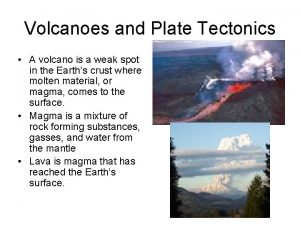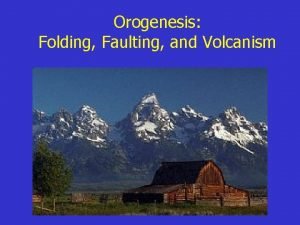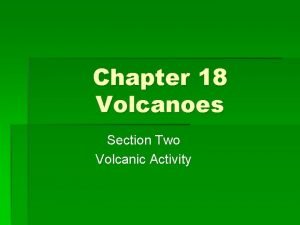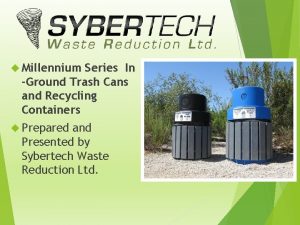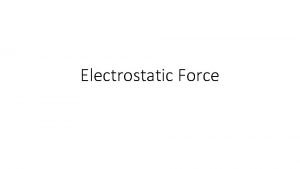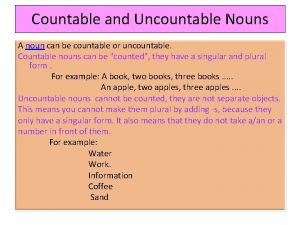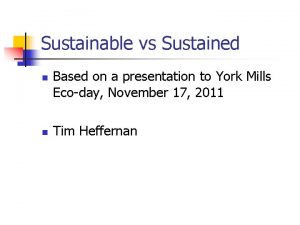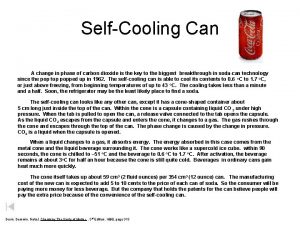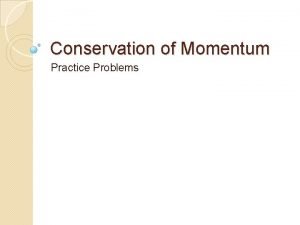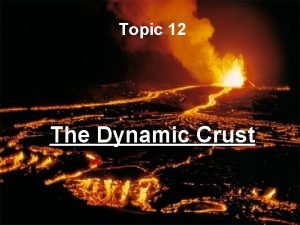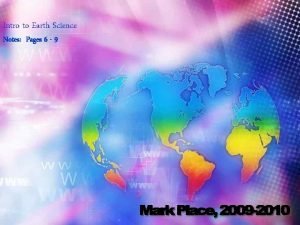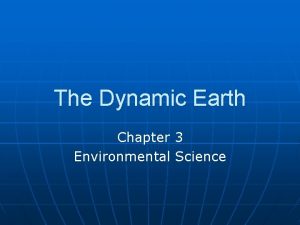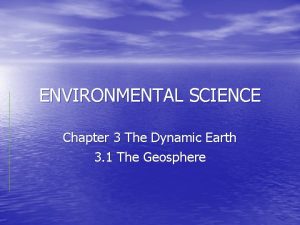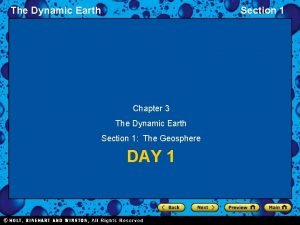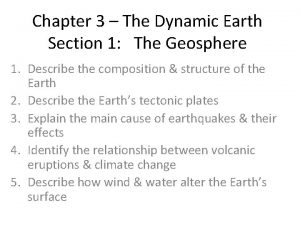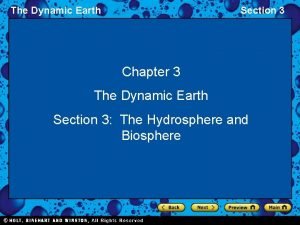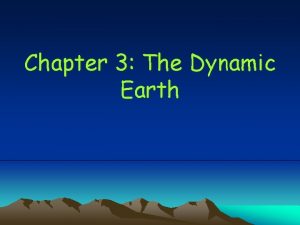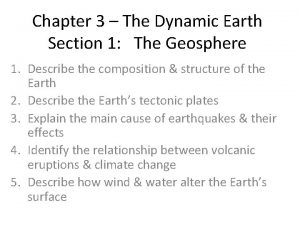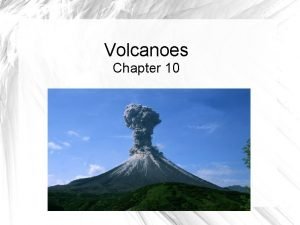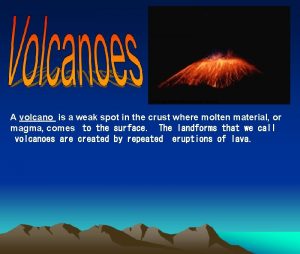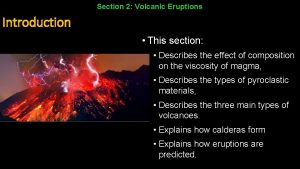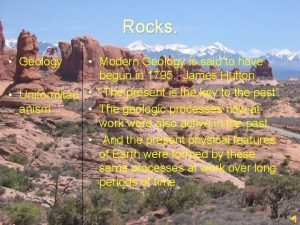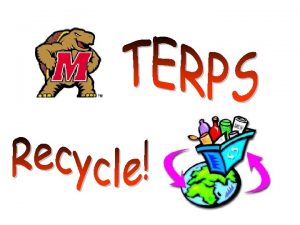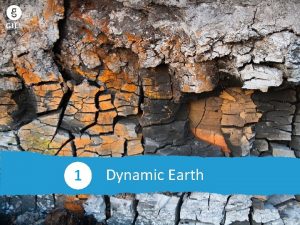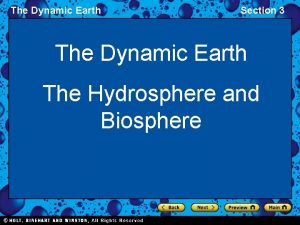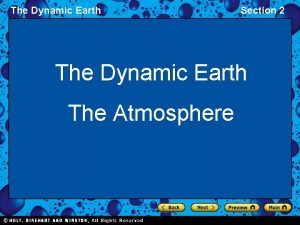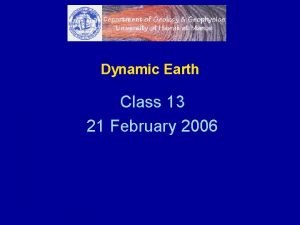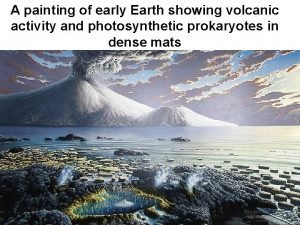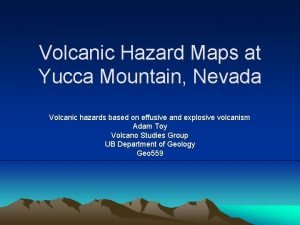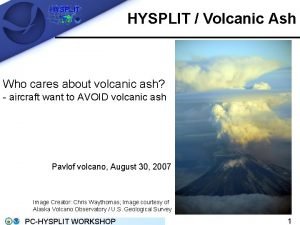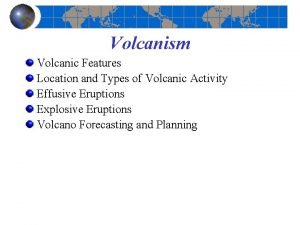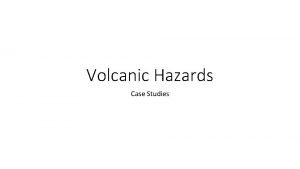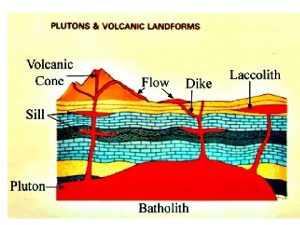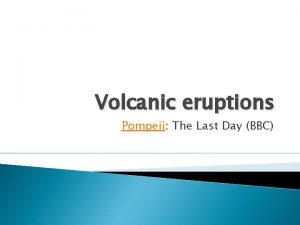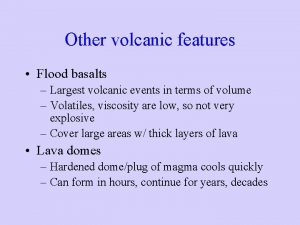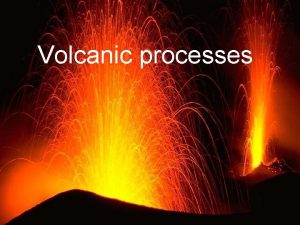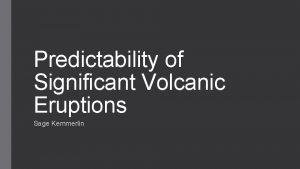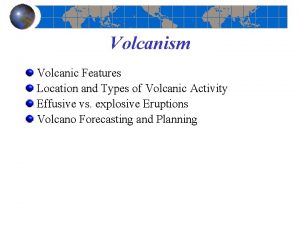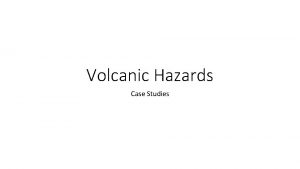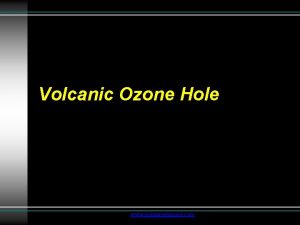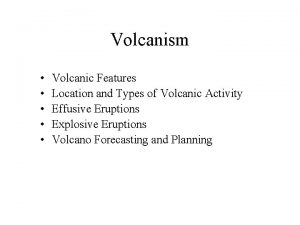DYNAMIC EARTH VOLCANIC ACTIVITY 1 I Cans Volcanic







![COMPOSITE VOLCANO [stratovolcano] • Symmetrical cone built from alternating quiet and explosive eruptions. • COMPOSITE VOLCANO [stratovolcano] • Symmetrical cone built from alternating quiet and explosive eruptions. •](https://slidetodoc.com/presentation_image/02856658ef36291e2b8eab13859486a5/image-8.jpg)








![1) The volcanic fragments –tephra- are unconsolidated [relatively loose] prone to weathering and erosion. 1) The volcanic fragments –tephra- are unconsolidated [relatively loose] prone to weathering and erosion.](https://slidetodoc.com/presentation_image/02856658ef36291e2b8eab13859486a5/image-17.jpg)















![Volcano’s classification [match term with definition] • Erupting or shows signs that it may Volcano’s classification [match term with definition] • Erupting or shows signs that it may](https://slidetodoc.com/presentation_image/02856658ef36291e2b8eab13859486a5/image-33.jpg)
![Volcano’s classification [match term with definition] • Erupting or shows signs that it may Volcano’s classification [match term with definition] • Erupting or shows signs that it may](https://slidetodoc.com/presentation_image/02856658ef36291e2b8eab13859486a5/image-34.jpg)




![OTHER FACTORS • WATER VAPOR [and/or CO 2 CONTENT]: it is present in the OTHER FACTORS • WATER VAPOR [and/or CO 2 CONTENT]: it is present in the](https://slidetodoc.com/presentation_image/02856658ef36291e2b8eab13859486a5/image-39.jpg)




![Black Hills, south Dakota [laccolith] 44 Black Hills, south Dakota [laccolith] 44](https://slidetodoc.com/presentation_image/02856658ef36291e2b8eab13859486a5/image-44.jpg)
- Slides: 44

DYNAMIC EARTH VOLCANIC ACTIVITY 1

I Can’s: Volcanic Activity • Compare and contrast the 3 main types of volcanic cones. • Summarize the relationship between lava types and the force of eruptions. • Explain what causes a volcanic eruption. • Predict the type of damage that will occur depending on the type of volcano and type of eruption that occurs. • Summarize the hazards caused by volcanic activity. • Identify the regions of volcanic activity, and summarize the process involved in the formation of those volcanoes. 2

Changes MAY OCCUR QUICKLY SLOWLY EARTHQUAKES VOLCANIC ERUPTIONS PLATES’ MOTION MOUNTAIN BUILDING WEATHERING, EROSION, DEPOSITION 3

TECTONICS VOLCANOES EARTHQUAKES MOUNTAIN BUILDING 4

TECTONICS VOLCANOES EARTHQUAKES MOUNTAIN BUILDING When magma reaches the surface, the lava cools and hardens to form new rock • volcanic mountains, • volcanic islands, • mid-ocean ridges • fissure volcanoes [Iceland] 5

EARTH is Geologically Active • Over 1500 different volcanoes erupted in the last 10, 000 years • Ash can form clouds that travel around the globe before raining back to Earth • Lava can destroy everything on its path [destructive force] or conversely form new crust / land [constructive force] 6

Types of Volcanoes The appearance of a volcano is determined by the nature of the eruption. The buildup of lava and tephra around the vent forms volcanic cones which are classified into three types: • Composite [most common] • Shield • Cinder-cone [rarest and usually smallest] 7
![COMPOSITE VOLCANO stratovolcano Symmetrical cone built from alternating quiet and explosive eruptions COMPOSITE VOLCANO [stratovolcano] • Symmetrical cone built from alternating quiet and explosive eruptions. •](https://slidetodoc.com/presentation_image/02856658ef36291e2b8eab13859486a5/image-8.jpg)
COMPOSITE VOLCANO [stratovolcano] • Symmetrical cone built from alternating quiet and explosive eruptions. • Layers of lava cover and protect the layers of loose materials [tephra] from erosion producing cones with steep-sided towering mountains. like layers of cake and frosting • Mount St. Helens, Mt Hood, Mt Rainier [Cascade Range] • Mount Fuji, Japan 8

Concave slopes Layers of Lava and Tephra 9

Mt. St Helens before the May 1980 eruption 10

Dome reforming Mt. St Helens after the 1980 eruption 11

Mount Rainier. Tacoma, Washington 12

CRATER Mount Rainier, summit view 13

Mount Rainier, looking into the crater 14

Mount Fuji from space 15

The slopes of composite volcanoes are known for being unstable and prone to landslides WHY? ? ? 16
![1 The volcanic fragments tephra are unconsolidated relatively loose prone to weathering and erosion 1) The volcanic fragments –tephra- are unconsolidated [relatively loose] prone to weathering and erosion.](https://slidetodoc.com/presentation_image/02856658ef36291e2b8eab13859486a5/image-17.jpg)
1) The volcanic fragments –tephra- are unconsolidated [relatively loose] prone to weathering and erosion. 2) The steepness of the sides also increases the possibility of landslide. 17

It is the cinders and ash and other "ejecta" that are thrown out of the volcano. Most of it lands right near the vent and builds up a steep pile around the vent. That pile is at the "angle of repose" meaning that it builds the steepest angle that the particles can maintain. Once it gets to that angle, additional cinders roll down off the side, but it keeps that steep slope as it builds up. During rainstorms, especially, the added weight of the water and the slurry created by water added to ash can cause big sections of the material to suddenly move downhill. Another thing that can happen is that the size of the ejecta changes periodically for a composite volcano so that sometime it is mostly ash and other times it is cinders of a particular size. Each of these materials has a different angle of repose. When a layer of one material with a high angle of repose builds up over a layer that has a low angle of repose, the added weight on top of the lower layer can cause massive slippage along the surface between the two. 18

SHIELD VOLCANO • Mainly built up from fluid basaltic lava flows. • Shaped more like a dome than a tall cone. – Large, gently sloping sides with nearly circular base • Quiet eruptions due to basaltic lava low viscosity • Largest active volcano: – Mauna Loa: Hawaii • 5 1/2 miles high (3 miles underwater and 2 1/2 miles above sea level). • 5 miles is buried into the Pacific plate [if included, this structure is about 10 miles high!] 19

20

Mauna Loa 21

Mauna Loa 22

Mauna Loa skies 23

24

Composite volcanoes Encountered at subduction zones -andesitic composition -steep cones, explosive

Why do shield and composite volcanoes differ in composition? Basaltic magmas rise along fractures through the basaltic layer. Due to the absence of granitic crustal layer, magmas are not changed in composition and they form basaltic volcanoes. Mountainous belts have thick roots of granite rock. Magmas rise slowly or intermittently along fractures in the crust; during passage through the granite layer, magmas are commonly modified or changed in composition and erupt on the surface to form volcanoes constructed of nonbasaltic (andesitic) rocks.

CINDER-CONE VOLCANO • Formed when material ejected high into the air falls back and piles up around the vent • Steep sides [40°], generally small [< 500 m high] • Eruptions can be explosive due to andesitic lava – Paricutin volcano, Mexico, grew very rapidly over the first year [1943] • 40 m within 24 hours, and 336 m after one year 27

28

29

Paricutin, Mexico 30

Paricutin, Mexico grew steadily during a 9 year period -in the middle of a cornfield- 31

32
![Volcanos classification match term with definition Erupting or shows signs that it may Volcano’s classification [match term with definition] • Erupting or shows signs that it may](https://slidetodoc.com/presentation_image/02856658ef36291e2b8eab13859486a5/image-33.jpg)
Volcano’s classification [match term with definition] • Erupting or shows signs that it may erupt in the near future. • Not presently erupting but erupt again in the near future. • Unlikely to erupt again • DORMANT • ACTIVE • EXTINCT 33
![Volcanos classification match term with definition Erupting or shows signs that it may Volcano’s classification [match term with definition] • Erupting or shows signs that it may](https://slidetodoc.com/presentation_image/02856658ef36291e2b8eab13859486a5/image-34.jpg)
Volcano’s classification [match term with definition] • Erupting or shows signs that it may erupt in the near future. • Not presently erupting but may erupt again in the near future. • Unlikely to erupt again • ACTIVE • DORMANT • EXTINCT 34

MAGMA COMPOSITION • MIXTURE OF – MOLTEN ROCKS – DISSOLVED GASES • [water vapor, CO 2, minor amounts of S, Cl, F ] – SUSPENDED MINERAL GRAINS • [crystals] 35

FACTORS related to Magma Formation COMPOSITION: • the types of minerals determine the melting temperature • HIGH melting point with single-chain of silicates [Si. O 4] and Ca-rich feldspar • LOW melting point with complex chain of silicates and Na-rich feldspar 36

MAGMA FORMATION • Under normal conditions, the geothermal gradient, which is how the temperature in the Earth changes with depth or pressure, is not high enough to melt rocks, and thus with the exception of the outer core, most of the Earth is solid.

FACTORS related to Magma Formation Temperature Pressure Water Pressure Temperature Melting point of Wet albite Increasing depth Increases below Earth’s surface Increases Decreasing depth below Earth’s surface Decreases increases Decreases 38
![OTHER FACTORS WATER VAPOR andor CO 2 CONTENT it is present in the OTHER FACTORS • WATER VAPOR [and/or CO 2 CONTENT]: it is present in the](https://slidetodoc.com/presentation_image/02856658ef36291e2b8eab13859486a5/image-39.jpg)
OTHER FACTORS • WATER VAPOR [and/or CO 2 CONTENT]: it is present in the pore space of some rocks and bound into the crystal structure of some minerals – At any given pressure, the melting temperature DECREASES as the water content increases – For example, Granite, with a higher water content than Basalt, melts at a lower Tº 39

OTHER FACTORS PRESSURE: • As the depth Pressure also because of the weight of the overlying rocks • It explains why MOST of the rocks in the earth’s lower crust and upper mantle do not melt to form magma 40

Intrusive Activity Since magma is less dense than its surrounding , it will move upward and eventually come into contact with, or intrude the overlying rocks • Magma can force the overlying rocks apart and enter newly formed fissures • Magma causes blocks to break off, and melt • Magma can melt the rock into which it intrudes 41

PLUTONS When the magma cools, igneous rock bodies are formed and called PLUTONS They are classified according to their • size, • shape, and • relationship to surrounding rocks 42

PLUTONS • Batholiths and Stocks: – largest plutons • Laccoliths: – relatively small • Sills and Dykes: – intruding parallel to the layers of rocks – cutting across existing rocks 43
![Black Hills south Dakota laccolith 44 Black Hills, south Dakota [laccolith] 44](https://slidetodoc.com/presentation_image/02856658ef36291e2b8eab13859486a5/image-44.jpg)
Black Hills, south Dakota [laccolith] 44
 Volcanic belts form along the boundaries of earth's
Volcanic belts form along the boundaries of earth's Define folding faulting and volcanic activity
Define folding faulting and volcanic activity Lava erupts through an opening in earth’s crust called a
Lava erupts through an opening in earth’s crust called a Chapter 18 volcanic activity
Chapter 18 volcanic activity Spoilage of canned foods
Spoilage of canned foods In ground trash cans
In ground trash cans Magellan cans
Magellan cans Electrostatic force
Electrostatic force Airport lighting cans
Airport lighting cans How food becomes unsafe
How food becomes unsafe Potatoes is countable or uncountable
Potatoes is countable or uncountable On average 113 204 aluminum cans
On average 113 204 aluminum cans Wic discounts
Wic discounts Buoy vent valve
Buoy vent valve Buoy vent valve
Buoy vent valve Easter island chile
Easter island chile Self cooling can
Self cooling can Zaira spent 55 hours
Zaira spent 55 hours Momentum practice problems
Momentum practice problems Dynamic dynamic - bloom
Dynamic dynamic - bloom Earth's dynamic crust and interior topic 12
Earth's dynamic crust and interior topic 12 Dynamic equilibrium earth science
Dynamic equilibrium earth science Chapter 3 the dynamic earth
Chapter 3 the dynamic earth Chapter 3 the dynamic earth
Chapter 3 the dynamic earth Dynamic earth structure
Dynamic earth structure The dynamic earth chapter 3
The dynamic earth chapter 3 Chapter 3 the dynamic earth
Chapter 3 the dynamic earth Chapter 3 the dynamic earth section 1 the geosphere
Chapter 3 the dynamic earth section 1 the geosphere The dynamic earth chapter 3
The dynamic earth chapter 3 Starbucks core competencies
Starbucks core competencies Earth layers activity
Earth layers activity Reactants products and leftovers
Reactants products and leftovers Activity and activity coefficient
Activity and activity coefficient Aon project management
Aon project management Form content and use
Form content and use Activity 2 finding the sequence
Activity 2 finding the sequence 03 activity 1
03 activity 1 3
3 Factor affecting volcanic eruption
Factor affecting volcanic eruption Factor affecting volcanic eruption
Factor affecting volcanic eruption Primary and secondary effects of a tectonic hazard
Primary and secondary effects of a tectonic hazard How much is 100 grams
How much is 100 grams Volcanic ash
Volcanic ash Volcanic ash
Volcanic ash Volcanic or plutonic rock
Volcanic or plutonic rock
